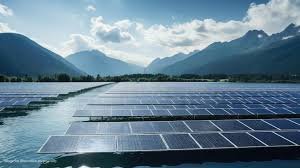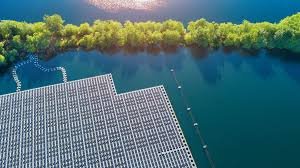SAIL Bhilai to Set Up Chhattisgarh’s First 15 MW Floating Solar Plant
Steel Authority of India Limited (SAIL) Bhilai is gearing up to pioneer a groundbreaking initiative in Chhattisgarh, with plans to establish the state’s inaugural 15 MW floating solar power plant. This ambitious project marks a significant stride towards sustainable energy solutions, combining innovation with environmental consciousness. The proposed facility is poised to revolutionize Chhattisgarh’s energy landscape, heralding a new era of renewable power generation in the region.
SAIL’s Vision for Sustainable Energy The initiative underscores SAIL’s steadfast commitment to sustainable development and green energy initiatives. By venturing into floating solar power, SAIL Bhilai aims to harness the vast potential of renewable resources while mitigating the ecological impact of conventional energy production methods. This endeavor aligns with the national objective of augmenting renewable energy capacity and reducing carbon emissions.
Technical Advancements in Solar Technology The advent of floating solar photovoltaic (PV) technology has introduced a paradigm shift in solar energy utilization. Unlike traditional ground-mounted solar systems, floating solar plants utilize water bodies, optimizing land usage and enhancing energy efficiency. This innovative approach not only addresses land scarcity concerns but also offers additional benefits such as reduced water evaporation and enhanced solar cell performance due to cooling effects.
Empowering Chhattisgarh’s Energy Sector Chhattisgarh, endowed with abundant natural resources, holds immense potential for renewable energy development. The establishment of the 15 MW floating solar plant by SAIL Bhilai not only contributes to the state’s renewable energy targets but also stimulates economic growth and employment opportunities. Furthermore, the project exemplifies the pivotal role of public-private partnerships in fostering sustainable development and energy security.
Environmental Implications and Sustainability Floating solar plants exemplify a harmonious coexistence between energy generation and environmental preservation. By harnessing solar energy atop water bodies, these installations minimize land footprint and mitigate ecosystem disruption, offering a sustainable alternative to conventional power plants. Moreover, the adoption of renewable energy sources aligns with global efforts to combat climate change and foster a greener future.

Why this News is Important:
Pioneering Sustainable Solutions The decision by SAIL Bhilai to establish Chhattisgarh’s first 15 MW floating solar plant underscores the imperative of embracing sustainable energy solutions. This initiative symbolizes a paradigm shift towards renewable energy sources, aligning with national goals of energy security and environmental preservation.
Fostering Technological Advancements The adoption of floating solar PV technology represents a significant technological leap in the realm of solar energy utilization. By leveraging water bodies for solar power generation, SAIL Bhilai sets a precedent for innovation and efficiency in the renewable energy sector, paving the way for future advancements.
Boosting Regional Development The establishment of the floating solar plant not only augments Chhattisgarh’s renewable energy capacity but also stimulates economic growth and job creation. This project holds the potential to catalyze infrastructure development and attract investments, fostering sustainable socio-economic progress in the region.
Historical Context:
In recent years, there has been a global paradigm shift towards renewable energy sources as nations strive to reduce dependency on fossil fuels and mitigate climate change. India, in line with its commitment to the Paris Agreement, has set ambitious targets for renewable energy capacity addition, prompting companies like SAIL Bhilai to explore innovative avenues for sustainable energy production.
Key Takeaways from “SAIL Bhilai to Set Up Chhattisgarh’s First 15 MW Floating Solar Plant”:
| Serial Number | Key Takeaway |
|---|---|
| 1. | SAIL Bhilai plans to establish Chhattisgarh’s first 15 MW floating solar power plant, marking a significant milestone in the state’s renewable energy journey. |
| 2. | The initiative underscores SAIL’s commitment to sustainable development and green energy initiatives, aligning with national objectives of enhancing renewable energy capacity. |
| 3. | Floating solar PV technology offers a novel approach to solar energy utilization, optimizing land usage and mitigating environmental impact while enhancing energy efficiency. |
| 4. | The project holds immense potential for regional development, stimulating economic growth, job creation, and infrastructure enhancement in Chhattisgarh. |
| 5. | The establishment of the floating solar plant exemplifies a strategic shift towards renewable energy adoption, fostering environmental sustainability and energy security. |
Important FAQs for Students from this News
1. What is a floating solar power plant?
- A floating solar power plant is a solar energy installation built on water bodies such as lakes, reservoirs, or ponds. Unlike traditional ground-mounted solar panels, floating solar plants utilize water surfaces to generate electricity.
2. How does floating solar PV technology work?
- Floating solar PV technology involves installing solar panels on floating structures anchored to the water body’s surface. These panels harness sunlight to generate electricity, which is then transmitted to the grid or stored in batteries for later use.
3. What are the advantages of floating solar plants over land-based systems?
- Floating solar plants offer several advantages, including optimized land usage, reduced water evaporation, enhanced solar panel efficiency due to cooling effects, and minimized environmental impact by utilizing otherwise unused water surfaces.
4. How does the establishment of the floating solar plant contribute to sustainable development?
- By harnessing renewable energy from sunlight, the floating solar plant reduces dependency on fossil fuels, mitigates greenhouse gas emissions, and fosters environmental sustainability. Additionally, the project promotes economic growth and job creation in the region.
5. What is the significance of SAIL Bhilai’s initiative in setting up Chhattisgarh’s first floating solar plant?
- SAIL Bhilai’s endeavor symbolizes a pioneering effort towards renewable energy adoption in Chhattisgarh, aligning with national objectives of enhancing energy security and combating climate change. The project sets a precedent for technological innovation and sustainable development in the state.
Some Important Current Affairs Links
















